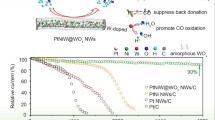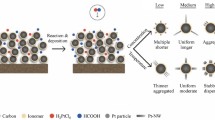Abstract
The high cost of platinum (Pt)-group metal (PGM)-based catalysts used in proton-exchange membrane fuel cells (PEMFCs) poses a critical roadblock to their widespread adoption. Although using low PGM loading PEMFCs can largely address this challenge, high current density performance will be severely compromised consequently. To overcome this dilemma, we report the development of ultra-thin platinum-cobalt nanowires (PtCoNWs) as the cathode catalysts for ultralow Pt loading and high-performance membrane electrode assembly (MEA). The PtCoNWs delivered a record-high mass activity (MA) of 1.06 ± 0.14 AmgPt−1 of Pt-alloy catalysts towards oxygen reduction reaction (ORR) in MEA, yielding an impressive total Pt utilization of 5.14 WratedmgPt−1. The PtCoNWs retained a respectable end-of-life MA of 0.45 A mgPt−1 after the 30,000 cycles square-wave accelerated stability test, which is still above the Department of Energy 2020 beginning-of-life target for catalysts. In-situ X-ray absorption spectroscopy studies suggest that the high degree of alloying in the PtCoNWs stabilizes the ultrathin structure and may contribute to the high ORR activity and power density performance in PEMFC.

摘要
质子交换膜燃料电池(PEMFC)中使用的高成本铂族金属(PGM)催化剂阻碍了其广泛应用. 尽管使用低铂负载量的燃料电池可以很大程度克服这一挑战, 但是电池的高电流密度性能将因此严重降低. 为了克服这一两难困境, 我们报道了超细铂钴纳米线(PtCoNWs)作为超低铂负载和高性能膜电极组件(MEA)阴极催化剂的开发. PtCoNWs在MEA中的氧还原反应(ORR)展现出1.06 ± 0.14 A mgPt−1的破纪录的高质量活性(MA), 因此获得了5.14 W ratemgPt−1的极佳的铂利用率. 在30,000次方波加速稳定性测试(AST)后, PtCoNW保持了0.45 A mgPt−1的可观的终止寿命(EOL)质量活性, 仍高于美国能源部2020年催化剂寿命开始(BOL)目标. 原位X射线吸收光谱(XAS)研究表明, PtCoNWs中的高度合金化稳定了超细结构, 并可能有助于PEMFC中的高ORR活性和功率密度性能.
Similar content being viewed by others
References
Debe MK. Electrocatalyst approaches and challenges for automotive fuel cells. Nature, 2012, 486: 43–51
Wang XX, Swihart MT, Wu G. Achievements, challenges and perspectives on cathode catalysts in proton exchange membrane fuel cells for transportation. Nat Catal, 2019, 2: 578–589
Kodama K, Nagai T, Kuwaki A, et al. Challenges in applying highly active Pt-based nanostructured catalysts for oxygen reduction reactions to fuel cell vehicles. Nat Nanotechnol, 2021, 16: 140–147
Wu J, Yang H. Platinum-based oxygen reduction electrocatalysts. Acc Chem Res, 2013, 46: 1848–1857
Whiston MM, Azevedo IL, Litster S, et al. Expert assessments of the cost and expected future performance of proton exchange membrane fuel cells for vehicles. Proc Natl Acad Sci U S A, 2019, 116: 4899–4904
Kongkanand A, Mathias MF. The priority and challenge of high-power performance of low-platinum proton-exchange membrane fuel cells. J Phys Chem Lett, 2016, 7: 1127–1137
DRIVE US. Fuel cell technical team roadmap. Secondary fuel cell technical team roadmap, 2017, November: https://www.energy.gov/sites/prod/files/2017/11/f46/FCTT_Roadmap_Nov_2017_FINAL.pdf
Kriston Á, Xie T, Gamliel D, et al. Effect of ultra-low Pt loading on mass activity of polymer electrolyte membrane fuel cells. J Power Sources, 2013, 243: 958–963
Fan J, Chen M, Zhao Z, et al. Bridging the gap between highly active oxygen reduction reaction catalysts and effective catalyst layers for proton exchange membrane fuel cells. Nat Energy, 2021, 6: 475–486
Tian X, Zhao X, Su YQ, et al. Engineering bunched Pt-Ni alloy nanocages for efficient oxygen reduction in practical fuel cells. Science, 2019, 366: 850–856
Li J, Sharma S, Liu X, et al. Hard-magnet L10-CoPt nanoparticles advance fuel cell catalysis. Joule, 2019, 3: 124–135
Liu Z, Zhao Z, Peng B, et al. Beyond extended surfaces: Understanding the oxygen reduction reaction on nanocatalysts. J Am Chem Soc, 2020, 142: 17812–17827
Li M, Zhao Z, Cheng T, et al. Ultrafine jagged platinum nanowires enable ultrahigh mass activity for the oxygen reduction reaction. Science, 2016, 354: 1414–1419
Sandbeck DJS, Secher NM, Inaba M, et al. The dissolution dilemma for low Pt loading polymer electrolyte membrane fuel cell catalysts. J Electrochem Soc, 2020, 167: 164501
Lu Y, Du S, Steinberger-Wilckens R. One-dimensional nanostructured electrocatalysts for polymer electrolyte membrane fuel cells—A review. Appl Catal B-Environ, 2016, 199: 292–314
Chen Y, Cheng T, Goddard III WA. Atomistic explanation of the dramatically improved oxygen reduction reaction of jagged platinum nanowires, 50 times better than Pt. J Am Chem Soc, 2020, 142: 8625–8632
Fuchs T, Drnec J, Calle-Vallejo F, et al. Structure dependency of the atomic-scale mechanisms of platinum electro-oxidation and dissolution. Nat Catal, 2020, 3: 754–761
Bu L, Guo S, Zhang X, et al. Surface engineering of hierarchical platinum-cobalt nanowires for efficient electrocatalysis. Nat Commun, 2016, 7: 11850
Jiang K, Zhao D, Guo S, et al. Efficient oxygen reduction catalysis by subnanometer Pt alloy nanowires. Sci Adv, 2017, 3: e1601705
Stephens IEL, Rossmeisl J, Chorkendorff I. Toward sustainable fuel cells. Science, 2016, 354: 1378–1379
Sievers GW, Jensen AW, Quinson J, et al. Self-supported Pt-CoO networks combining high specific activity with high surface area for oxygen reduction. Nat Mater, 2021, 20: 208–213
Arruda TM, Shyam B, Ziegelbauer JM, et al. Investigation into the competitive and site-specific nature of anion adsorption on Pt using in situ X-ray absorption spectroscopy. J Phys Chem C, 2008, 112: 18087–18097
Jia Q, Liang W, Bates MK, et al. Activity descriptor identification for oxygen reduction on platinum-based bimetallic nanoparticles: In situ observation of the linear composition-strain-activity relationship. ACS Nano, 2015, 9: 387–400
Newville M. IFEFFIT: Interactive XAFS analysis and FEFF fitting. J Synchrotron Rad, 2001, 8: 322–324
Ravel B, Newville M. ATHENA, ARTEMIS, HEPHAESTUS: Data analysis for X-ray absorption spectroscopy using IFEFFIT. J Synchrotron Rad, 2005, 12: 537–541
Newville M, Livins P, Yacoby Y, et al. Near-edge X-ray-absorption fine structure of Pb: A comparison of theory and experiment. Phys Rev B, 1993, 47: 14126–14131
Ankudinov AL, Ravel B, Rehr JJ, et al. Real-space multiple-scattering calculation and interpretation of X-ray-absorption near-edge structure. Phys Rev B, 1998, 58: 7565–7576
Hlil EK, Baudoing-Savois R, Moraweck B, et al. X-ray absorption edges in platinum-based alloys. 2. Influence of ordering and of the nature of the second metal. J Phys Chem, 1996, 100: 3102–3107
Jia Q, Caldwell K, Ramaker DE, et al. In situ spectroscopic evidence for ordered core-ultrathin shell Pt1Co1 nanoparticles with enhanced activity and stability as oxygen reduction electrocatalysts. J Phys Chem C, 2014, 118: 20496–20503
Hwang BJ, Sarma LS, Chen JM, et al. Structural models and atomic distribution of bimetallic nanoparticles as investigated by X-ray absorption spectroscopy. J Am Chem Soc, 2005, 127: 11140–11145
Kim HY, Kim JM, Ha Y, et al. Activity origin and multifunctionality of Pt-based intermetallic nanostructures for efficient electrocatalysis. ACS Catal, 2019, 9: 11242–11254
Wang Z, Yao X, Kang Y, et al. Structurally ordered low-Pt intermetallic electrocatalysts toward durably high oxygen reduction reaction activity. Adv Funct Mater, 2019, 29: 1902987
Han B, Carlton CE, Kongkanand A, et al. Record activity and stability of dealloyed bimetallic catalysts for proton exchange membrane fuel cells. Energy Environ Sci, 2015, 8: 258–266
Chong L, Wen J, Kubal J, et al. Ultralow-loading platinum-cobalt fuel cell catalysts derived from imidazolate frameworks. Science, 2018, 362: 1276–1281
Zhao Z, Hossain MD, Xu C, et al. Tailoring a three-phase microenvironment for high-performance oxygen reduction reaction in proton exchange membrane fuel cells. Matter, 2020, 3: 1774–1790
Shao Y, Yin G, Gao Y. Understanding and approaches for the durability issues of Pt-based catalysts for PEM fuel cell. J Power Sources, 2007, 171: 558–566
Beermann V, Holtz ME, Padgett E, et al. Real-time imaging of activation and degradation of carbon supported octahedral Pt-Ni alloy fuel cell catalysts at the nanoscale using in situ electrochemical liquid cell STEM. Energy Environ Sci, 2019, 12: 2476–2485
Takao S, Sekizawa O, Samjeské G, et al. Observation of degradation of Pt and carbon support in polymer electrolyte fuel cell using combined nano-X-ray absorption fine structure and transmission electron microscopy techniques. ACS Appl Mater Interfaces, 2018, 10: 27734–27744
Mardle P, Thirunavukkarasu G, Guan S, et al. Comparative study of PtNi nanowire array electrodes toward oxygen reduction reaction by half-cell measurement and PEMFC test. ACS Appl Mater Interfaces, 2020, 12: 42832–42841
Acknowledgements
Huang Y, Jia Q, and Duan X acknowledge the support from the Office of Naval Research (N000141812155). Huang Y acknowledges the support from the National Science Foundation (DMREF 1437263). This research used beamline 6-BM of the National Synchrotron Light Source II, a U.S. Department of Energy (DOE) Office of Science User Facility operated for the DOE Office of Science by Brookhaven National Laboratory under Contract No. DE-SC0012704. The authors acknowledge the use of facilities and instrumentation at the UC Irvine Materials Research Institute (IMRI), which is supported in part by the National Science Foundation through the UC Irvine Materials Research Science and Engineering Center (DMR-2011967). The authors also acknowledge the Electron Imaging Center of Nanomachines at CNSI, UC Los Angeles for TEM support.
Author information
Authors and Affiliations
Contributions
Huang Y supervised the project. Huang J and Peng B designed and performed the experiments. Stracensky T and Jia Q performed the XAS characterization. Xu M helped with the STEM characterization. Liu Z and Zhao Z helped with the MEA measurement. Liu Y and Zhang A helped with the synthesis of catalysts. Huang J, Peng B, and Huang Y wrote and revised the manuscript. All authors reviewed and commented on the manuscript.
Corresponding author
Additional information
Conflict of interest
The authors declare that they have no conflict of interest.
Jin Huang received his B.Eng. degree from the School of Materials Science and Engineering, Wuhan University of Technology (WUT) in 2016. He is currently a PhD candidate at the Department of Materials Science and Engineering, the University of California, Los Angeles (UCLA) under Prof. Yu Huang’s supervision. His research is focused on the catalysis for energy conversion.
Bosi Peng received her BS degree from the College of Chemistry and Molecular Sciences, Wuhan University in 2017. She is currently a PhD candidate at the Department of Chemistry and Biochemistry, the UCLA under the supervision of Prof. Yu Huang and Prof. Xiangfeng Duan. Her research interests include electrocatalysis for clean energy conversion.
Yu Huang is currently a full professor and chair of the Department of Materials Science and Engineering at the UCLA. Her research centers around mechanistic understanding of nanoscale phenomena and exploiting the unique properties of nanoscale materials for various applications including materials synthesis, catalysis, fuel cells, biomedical and device applications.
Supplementary Information
Rights and permissions
About this article
Cite this article
Huang, J., Peng, B., Stracensky, T. et al. 1D PtCo nanowires as catalysts for PEMFCs with low Pt loading. Sci. China Mater. 65, 704–711 (2022). https://doi.org/10.1007/s40843-021-1777-x
Received:
Accepted:
Published:
Issue Date:
DOI: https://doi.org/10.1007/s40843-021-1777-x




